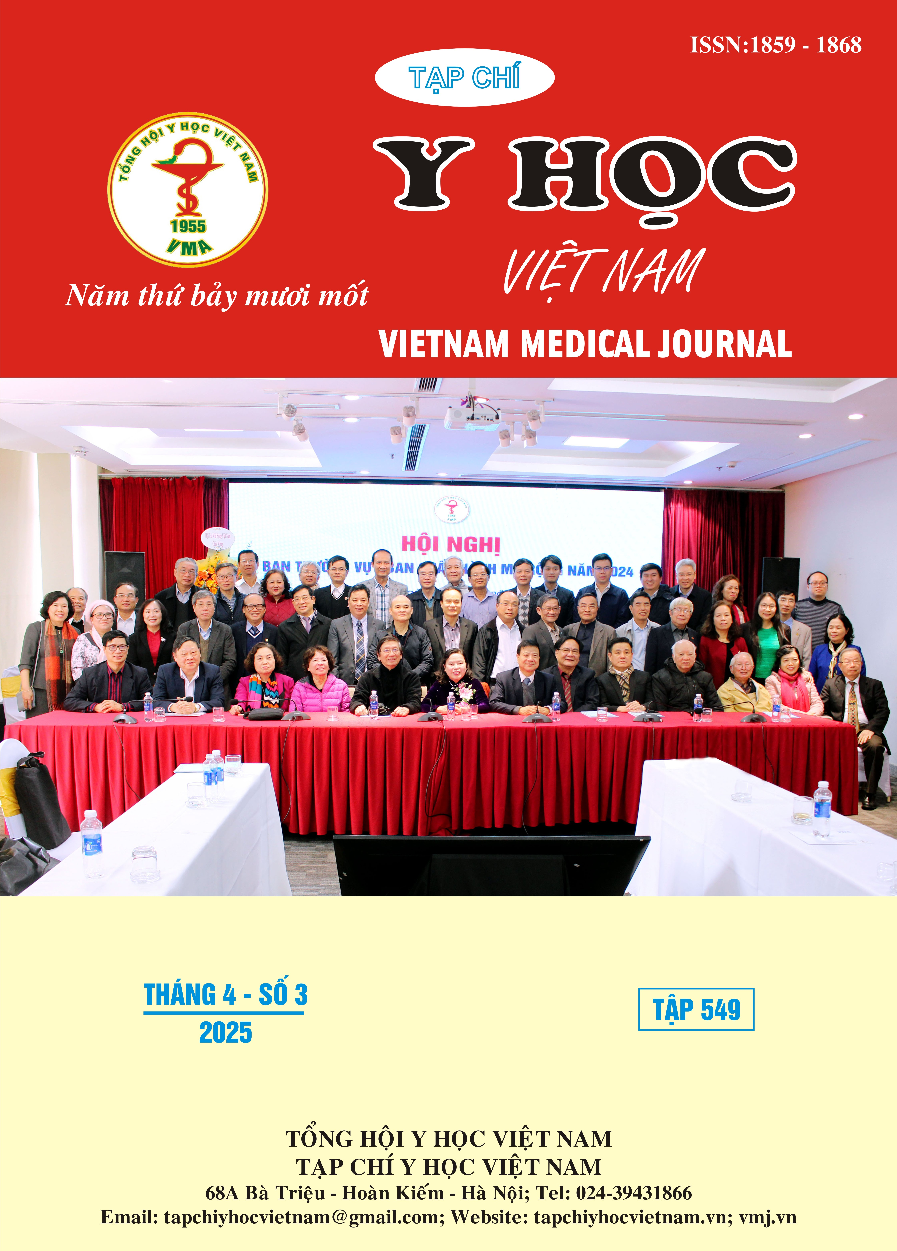KẾT QỦA PHẪU THUẬT KHÂU GẤP NẾP CƠ HOÀNH ĐIỀU TRỊ LIỆT HOÀNH SAU MỔ TIM BẨM SINH
Nội dung chính của bài viết
Tóm tắt
Mục tiêu: Mô tả triệu chứng lâm sàng, cận lâm sàng và kết quả phẫu thuật khâu gấp nếp cơ hoành điều trị liệt hoành sau mổ tim bẩm sinh. Tóm tắt: Liệt hoành sau mổ tim là một biến chứng nặng ảnh hưởng đến hô hấp của bệnh nhân, tuỳ từng nghiên cứu tỷ lệ giao động từ 0,3 đến 12,8%. Liệt hoành do tổn thương thần kinh hoành có thể xảy ra khi cắt tuyến ức, gỡ dính màng ngoài tim với bệnh nhân đã mổ cũ, hoặc do bỏng dây thần kinh hoành khi sử dụng dao điện. Triệu chứng lâm sàng có như biểu biện thở máy kéo dài, suy hô hấp, viêm phổi, trẻ lớn có thể không có biểu hiện lâm sàng. Chẩn đoán xác định bằng chụp xquang ngực, siêu âm hoặc soi cơ hoành dưới màn tăng sáng để quan sát sự di động của cơ hoành. Điều trị có nhiều phác đồ khác nhau, song với trẻ nhỏ thì phương pháp khâu gấp nếp cơ hoành được chỉ định rộng rãi. Để đánh giá triệu chứng lâm sàng, cận lâm sàng, kết quả phẫu thuật khâu gấp nếp cơ hoành điều trị liệt hoành sau mổ tim bẩm sinh chúng tôi tiến hành nghiên cứu này. Phương pháp nghiên cứu: Mô tả cắt ngang, hồi cứu. 28 bệnh nhân liệt hoành sau mổ tim bẩm sinh từ tháng 1/2020 đến tháng 12 năm 2024. Kết quả: Có 28 bệnh nhân bị liệt hoành trong tổng số 1839 bệnh nhân được phẫu thuật, trong đó có 6 bệnh nhân mổ lần đầu (1 sau mổ tĩnh mạch phổi lạc chỗ, 2 sau mổ vá thông liên thất, 1 sau mổ sửa toàn bộ tứ chứng Fallot, 2 sau mổ góp tuần hoàn bàng hệ) và 22 bệnh nhân mổ lần 2 (8 đã mổ Glenn , 8 sau mổ Fontan, 3 sau mổ thay conduit động mạch phổi, 2 sửa toàn bộ thông sàn nhĩ thất, 1 bệnh nhân sau mổ Senning). Tuổi giao động từ 2 tháng đến 13 tuổi. Dấu hiệu chủ yếu để phát hiện liệt hoành là thở máy kéo dài, rút máy thở thất bại (18 bệnh nhân), khó thở và thở nhanh sau mổ là 6 bệnh nhân, khám lại có biểu hiện khó thở nhẹ và phim chụp xquang có dấu hiệu liệt cơ hoành 4 bệnh nhân. Thời gian từ khi mổ tim đến mổ khâu gấp nếp cơ hoành 5 ngày đến 3 tháng. Có 3 bệnh nhân tử vong do suy đa tạng, các bệnh nhân có sự hồi phục hô hấp sau mổ. Cơ hoành trở lại vị trí bình thường sau mổ 1 tháng là 20 bệnh nhân, 5 bệnh nhân trở lại vị trí bình thường sau 3 tháng. Trong thời gian theo dõi trung bình 16 tháng, có 6 bệnh nhân tiếp tục phẫu thuật tim tiếp theo, không có bệnh nhân bị viêm phổi hoặc suy hô hấp. Kết luận: dấu hiệu chủ yếu của liệt hoành sau mổ tim bẩm sinh là thời gian thở máy kéo dài và thất bại trong rút nội khí quản. Phẫu thuật khâu gấp nếp cơ hoành sớm giúp phục hồi hô hấp cho bệnh nhân.
Chi tiết bài viết
Từ khóa
liệt hoành, sau mổ tim bẩm sinh, khâu gấp nếp cơ hoành
Tài liệu tham khảo
2. Affatato A, Villagra F . Phrenic nerve paralysis following pediatric cardiac surgery. Role of diaphragmatic plication. J Cardiovasc Surg (1988);29:606–9.
3. De Leeuw M . Impact of diaphragmatic paralysis after cardiothoracic Surgery in children. J Thorac Cardiovasc Surg (1999);118(3):510–7
4. Ergin Arslanoğlu. Congenital cardiac surgery and diaphragmatic paralysis: efficacy of diaphragm plication. The Cardiothoracic Surgeon (2024) volume 32, Article number: 5
5. Fraser CD 3rd, Ravekes W, Thibault D. Diaphragm paralysis after pediatric cardiac surgery: an STS Congenital Heart Surgery Database Study. Ann Thorac Surg(2021) 112(1):139–146
6. Georgiev S, Konstantinov G. Phrenic nerve injury after paediatric heart surgery: is aggressive plication of the diaphragm beneficial? Eur J Cardiothorac Surg (2013). 44:808–12
7. Ramadan A. T. Phrenic palsy after pediatric cardiac surgery: what is the best modality of management?. Egypt Cardiothorac Surg 2023.5(1):12–17
8. Öztürk E, Tanıdır İC. Ultrasonographic postoperative evaluation of diaphragm function of patients with congenital heart defects. Turk Gogus Kalp Dama (2020), 28(1):70–75


